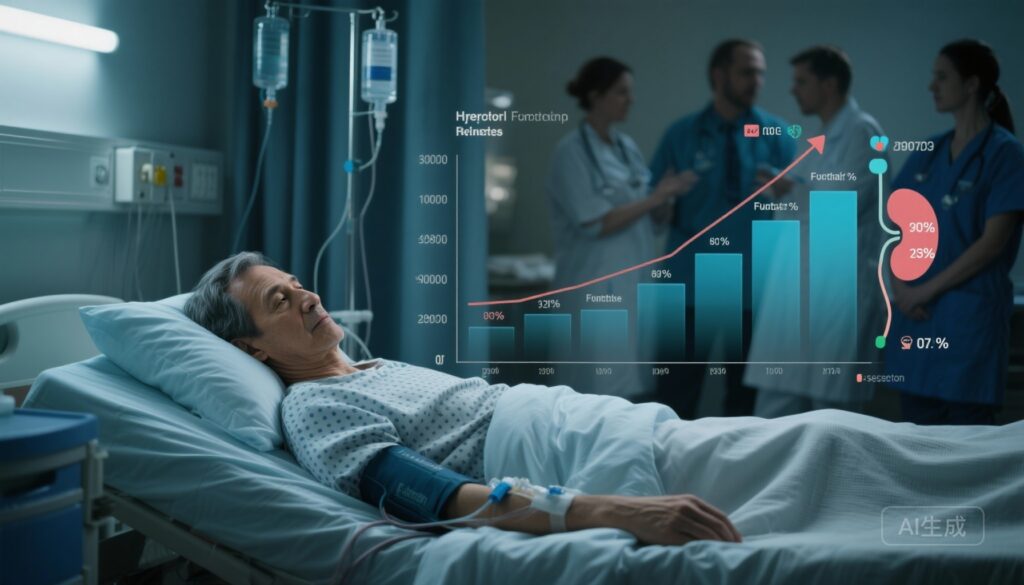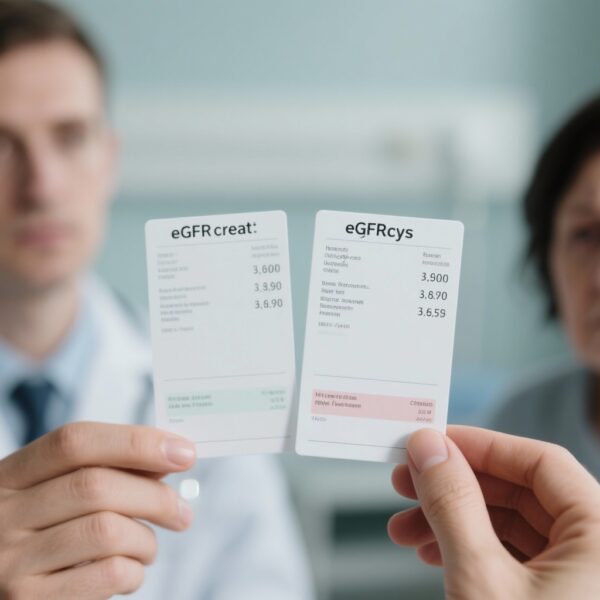Highlight
• In the LIBERATE-D randomized trial, a conservative, indication-based dialysis strategy yielded higher unadjusted rates of kidney recovery at hospital discharge (64% vs 50%; absolute difference 13.8%, 95% CI 0.8%–26.8%; P = .04).
• The conservative group had substantially fewer dialysis sessions per week (median 1.8 vs 3.1) and more dialysis-free days to day 28 (median difference 16 days).
• After prespecified adjustment for baseline covariates the effect estimate attenuated and was not statistically significant (adjusted OR 1.56, 95% CI 0.86–2.84; P = .15), underscoring the need for larger confirmatory trials.
Background
Acute kidney injury (AKI) that requires kidney replacement therapy (KRT) is a common and serious complication in hospitalized patients, particularly in the intensive care unit. When patients fail to recover intrinsic kidney function and remain dialysis-dependent, they face higher mortality, increased health care utilization, and reduced quality of life. Practice patterns for provision of intermittent hemodialysis in AKI vary widely. Some centers prescribe routine thrice-weekly intermittent hemodialysis (IHD) once patients are hemodynamically stable, while others use a more conservative, indication-driven approach that limits dialysis to clear metabolic or clinical triggers (for example, hyperkalemia, severe acidosis, refractory volume overload, or uremic complications).
Evidence on dialysis-dosing and modality in AKI has mostly focused on delivered intensity (dose) and modality (CRRT vs IHD), with large randomized trials (e.g., ATN, RENAL) showing no mortality benefit from higher-intensity regimens. However, fewer randomized data have addressed whether a constrained, conservative strategy that avoids scheduled routine dialysis sessions can expedite native kidney recovery and reduce dialysis-associated harms (for example, intradialytic hypotension) and resource use.
Study design
The Liberation From Acute Dialysis (LIBERATE-D) trial is a multicenter, unblinded, randomized superiority trial conducted at four U.S. centers. Between January 23, 2020, and March 10, 2025, the study enrolled adult hospitalized patients with dialysis-requiring AKI who had baseline estimated glomerular filtration rate (eGFR) >15 mL/min/1.73 m2, had already initiated KRT, and were hemodynamically stable with planned intermittent hemodialysis.
Of 909 patients screened, 221 were randomized and 220 received the allocated interventions. Randomization compared a conservative dialysis strategy versus conventional scheduled dialysis (three times per week) until prespecified urine output or creatinine clearance thresholds were met. The conservative approach delivered dialysis only when explicit metabolic or clinical indications were present. Patients had initiated KRT a median of 9 days (IQR 5–18.5) before randomization. The trial’s primary endpoint was recovery of kidney function at hospital discharge, defined as alive and dialysis-free for at least 14 consecutive days (including after discharge). Two prespecified key secondary endpoints were dialysis sessions per week and dialysis-free days to day 28. The trial registration number is NCT04218370.
Key findings
Population: The mean participant age was 56 years (SD 16), 67% were male, 13% Black, and 60% White. Mean baseline eGFR was 64.8 mL/min/1.73 m2 (SD 30.9). Participants were fairly heterogeneous with respect to timing and duration of prior KRT exposure prior to enrollment.
Primary outcome
In the unadjusted intention-to-treat analysis, kidney recovery at hospital discharge occurred in 70 of 109 participants (64%) in the conservative dialysis group compared with 55 of 109 participants (50%) in the conventional dialysis group. The absolute difference was 13.8% (95% CI, 0.8%–26.8%; P = .04). The unadjusted odds ratio was 1.76 (95% CI, 1.02–3.03; P = .04).
After the prespecified adjustment for baseline covariates, the effect estimate attenuated: adjusted OR 1.56 (95% CI, 0.86–2.84; P = .15), which crossed conventional thresholds for statistical significance.
Secondary outcomes and dialysis exposure
Participants randomized to the conservative strategy received fewer dialysis sessions per week: median 1.8 (IQR 0–2.6) versus 3.1 (IQR 2.6–3.5) in the conventional group. The median difference was −1.4 sessions per week (95% CI −1.8 to −1.0), a clinically meaningful reduction in dialysis exposure.
Time to recovery was shorter in the conservative group: median dialysis-free days to day 28 were 21 (IQR 0–28) versus 5 (IQR 0–21) in favor of the conservative strategy (median difference 16 days; 95% CI 5–27).
Safety and dialysis-associated harms
Dialysis-associated hypotension events were fewer in the conservative group (69 events) than in the conventional group (97 events), consistent with fewer treatments and less intradialytic physiologic stress. The published report did not identify a signal for excess metabolic complications from the conservative approach, but the trial was not powered to evaluate rare safety outcomes.
Interpretation and clinical implications
LIBERATE-D provides the most rigorous randomized evidence to date that a conservative, indication-driven IHD strategy in patients with dialysis-requiring AKI may shorten time to and increase rates of kidney recovery at hospital discharge, while substantially reducing dialysis exposure and associated hemodynamic instability.
Strengths of the trial include multicenter randomized design, pragmatic alignment with bedside clinical practice, objective primary endpoint (14 consecutive dialysis-free days), and detailed reporting of dialysis exposure and intradialytic events.
However, interpretation requires nuance. The primary unadjusted analysis met conventional statistical significance, but the prespecified adjusted analysis did not. This attenuation suggests that baseline imbalances or chance contributed to some of the observed effect and that the true effect size remains uncertain. The trial enrolled 220 treated participants — a meaningful size but relatively modest for robust estimation of effects and subgroup analyses. The unblinded design is pragmatic but can introduce bias in management decisions and outcome ascertainment, though the primary outcome (dialysis-free status) is relatively objective.
If the conservative strategy indeed increases recovery, plausible mechanisms include reduction in dialysis-mediated removal of uremic solutes important for renal repair, decreased episodes of intradialytic hypotension and renal ischemia, and avoidance of unnecessary fluid shifts that may impede renal recovery. The decreased dialysis frequency also reduces treatment-related exposure to anticoagulation, extracorporeal circuit-associated inflammation, and procedural complications.
Limitations and generalizability
Several limitations warrant emphasis. The trial excluded patients with baseline eGFR ≤15 mL/min/1.73 m2, so findings do not apply to patients with advanced pre-existing chronic kidney disease. Patients had often already received multiple days of KRT before enrollment, so the intervention tested a strategy for liberation rather than initial initiation practice. The unblinded design may have affected decisions about timing of dialysis cessation and discharge planning. Finally, although fewer intradialytic hypotension events were observed, the trial was not powered to detect differences in hard clinical endpoints such as mortality, long-term dialysis dependence at 90 days, or rehospitalization; these outcomes were not the primary focus of the publication and require further study.
What this means for practice and policy
For clinicians, LIBERATE-D supports the safety and potential benefit of an individualized, indications-driven approach to intermittent hemodialysis in hemodynamically stable patients with dialysis-requiring AKI who have preserved baseline kidney function. Adopting a conservative strategy can reduce the frequency of treatments and intradialytic hypotension and may increase the likelihood of renal recovery, though equipoise remains until larger trials confirm these findings and define patient subgroups most likely to benefit.
For health systems and policy-makers, a strategy that safely reduces dialysis sessions could lower resource use, shorten length of stay or outpatient dialysis needs, and decrease costs and burdens on dialysis capacity — particularly relevant in settings with constrained dialysis resources.
Future research
The authors appropriately call for larger confirmatory trials that are powered to evaluate the adjusted effect size, durability of recovery (at 90 days and beyond), mortality, and patient-centered outcomes such as quality of life and need for chronic dialysis. Key questions include identification of predictors of successful conservative management, protocols to standardize indication thresholds, and evaluation across diverse populations and care settings (including centers with different dialysis staffing models and resources).
Conclusion
The LIBERATE-D randomized clinical trial demonstrates that a conservative, indication-triggered intermittent hemodialysis strategy in selected patients with dialysis-requiring AKI led to fewer dialysis sessions, fewer dialysis-associated hypotension events, and higher unadjusted rates of kidney recovery at hospital discharge. Because the prespecified adjusted analysis did not meet statistical significance and the trial size was modest, the findings are hypothesis-generating and support testing this pragmatic strategy in larger, multicenter trials that evaluate long-term kidney outcomes and patient-centered endpoints.
Funding and trial registration
Trial registration: ClinicalTrials.gov Identifier: NCT04218370. The JAMA publication lists funding sources; readers should consult the full paper for detailed funding and conflict-of-interest disclosures.
References
1. Liu KD, Siew ED, Tuot DS, et al. A Conservative Dialysis Strategy and Kidney Function Recovery in Dialysis-Requiring Acute Kidney Injury: The Liberation From Acute Dialysis (LIBERATE-D) Randomized Clinical Trial. JAMA. 2025 Nov 7. doi:10.1001/jama.2025.21530. Epub ahead of print. PMID: 41201895.
2. Kidney Disease: Improving Global Outcomes (KDIGO) Acute Kidney Injury Work Group. KDIGO Clinical Practice Guideline for Acute Kidney Injury. Kidney Int Suppl. 2012;2:1–138.



